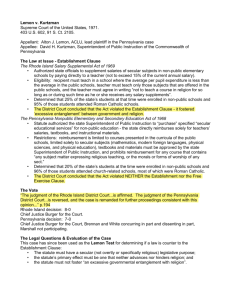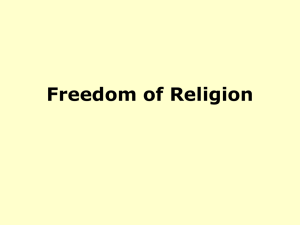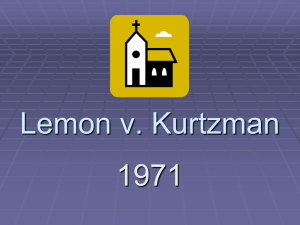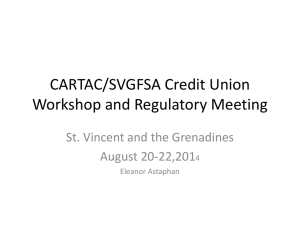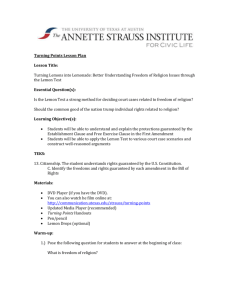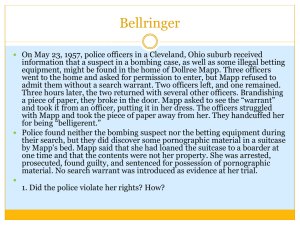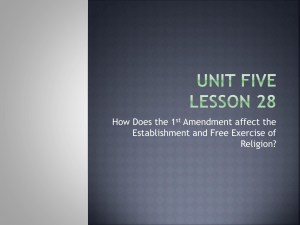Religious Establishment - Northern Illinois University
advertisement
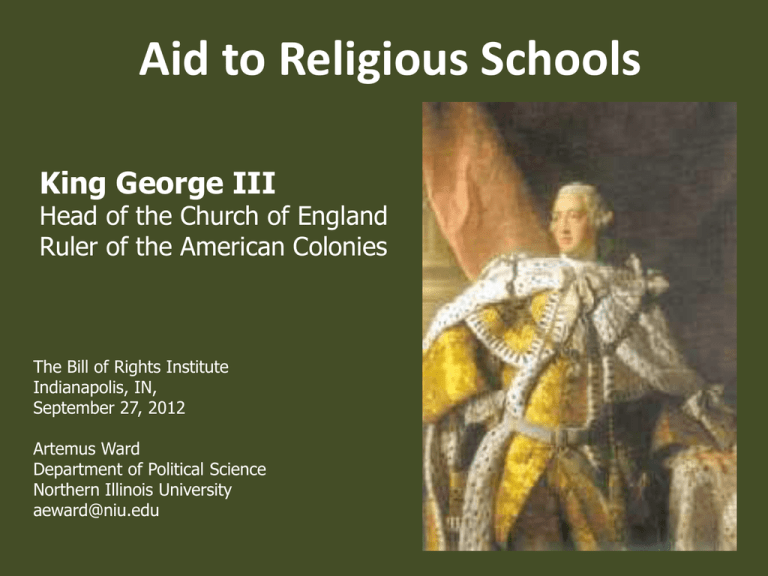
Aid to Religious Schools King George III Head of the Church of England Ruler of the American Colonies The Bill of Rights Institute Indianapolis, IN, September 27, 2012 Artemus Ward Department of Political Science Northern Illinois University aeward@niu.edu The “Wall of Separation” • The First Amendment states: “Congress shall make no law respecting an establishment of religion” • What does this mean? • In 1802, President Jefferson wrote a letter to the Danbury Baptist Association explaining that the First Amendment established “a wall of separation between church and state.” • Does this help us interpret the Establishment Clause? Competing Views of the Establishment Clause • Separationist—strict division between government and religion. • Accommodationist—allows intermingling between government and religion. • Liberals tend to be separationist while conservatives tend toward accommodationist positions. Bradfield v. Roberts (1899) • Can the government appropriate taxpayer dollars to religious institutions? • Bradfield was the Court’s first case in this area. A Washington, DC hospital operated by Catholic nuns received $30,000 from the U.S. Congress to construct facilities to treat indigent patients. • In an opinion by Justice Rufus Peckham, the Court unanimously held that the fact that the nuns administered the hospital was irrelevant. They examined the purpose of the institution and held that it was a hospital for the poor, which is a secular purpose. • This test became a core standard in establishment cases. Everson v. Board of Education (1947) • The Court upheld a state’s reimbursement to parents of parochial school children for the cost of busing their kids to religious schools. • The Court reasoned that the taxpayer funds were permissible because they went to the children/parents and not the religious schools. But . . . • The Court also said, “In the words of Jefferson, the clause against establishment of religion by law was intended to erect ‘a wall of separation between Church and State.’” Everson v. Board of Education (1947) • Writing for the 5-4 majority, Justice Hugo Black said: • “The ‘establishment of religion’ clause of the First Amendment means at least this: Neither a state nor the federal government can set up a church. • Neither can pass laws which aid one religion, aid all religions, or prefer one religion over another. • Neither can force nor influence a person to go to or to remain away from church against his will or force him to profess a belief or disbelief in any religion. • No person can be punished for entertaining or professing religious beliefs or disbeliefs, for church attendance or nonattendance. • No tax in any amount, large or small, can be levied to support any religious activities or institutions, whatever they may be called, or whatever form they may adopt to teach or practice religion. • Neither a state nor the Federal Government can, openly or secretly, participate in the affairs of any religious organizations or groups and vice versa.” Illinois ex rel. McCollum v. Board of Education (1948) • In the Court voted 8-1 to strike down a “release time” program in which religious instructors came to public school weekly and provided religious training for students whose parents so desired. • There were 2,000 communities nationwide offering similar programs for 1.5 million students. • Justice Black wrote: “[The facts] show the use of taxsupported property for religious instruction and the close cooperation between the school authorities and the religious council in promoting religious education. The operation of the state's compulsory education system thus assists and is integrated with the program of religious instruction carried on by separate religious sects. Pupils compelled by law to go to school for secular education are released … in part from their legal duty upon the condition that they attend the religious classes.” Zorach v. Clauson (1952) • The justices ruled 6-3 that programs where students are released for an hour or so early one day each week to obtain religious instruction off campus was permissible. • Justice William O. Douglas said that the prohibition against religious establishment “does not say that in every and all respects there shall be separation of Church and State.” If it did, according to Douglas, state and religion would be “hostile, suspicious, and even unfriendly” toward each other. • In one of the most often quoted passages in this area of the law, Douglas wrote: • “We are a religious people whose institutions presuppose a Supreme Being.” • The three dissenters—Black, Felix Frankfurter, and Robert Jackson—were all in the majority in McCollum and said that the facts in Zorach were essentially the same. Board of Education v. Allen (1968) • The justices upheld 6-3 a state program where public schools loaned secular textbooks to students attending private schools. • The Court reasoned that the primary purpose of the law was to further education, not religion. • Justice Byron White said, “the financial benefit is to parents and children, not schools.” Lemon v. Kurtzman (1971) • The Court invalidated a state law reimbursing religious schools for non-religious textbooks and salaries for non-religious teachers. • Chief Justice Warren Burger reasoned that unlike textbooks, it was easy for teachers to inject religion into their teaching. • Though the aid only went to teachers of "secular" subjects, they were employed by and subject to supervision and disciplinary action by the church. Because most lay teachers were of the Catholic faith, there was potential for public funds to be used for religious instruction. Because of this potential danger, the state would have to continually monitor the school to make sure the money was being distributed correctly. • This would be excessive involvement. Lemon v. Kurtzman (1971) • • 1) 2) 3) The Court articulated what became known as the “Lemon Test.” The policy must pass all 3 parts to be valid: Does program at issue have a secular legislative PURPOSE? Is the primary EFFECT to inhibit or advance religion? Does the legislation foster an EXECESSIVE GOVERNMENT ENTAGLEMENT with religion? This test became divisive in subsequent cases and though it has been slightly modified, it is essentially in tact as good law today. Applying the Lemon Test • In the years after Lemon, the justices’ record in applying the test was mixed. They reached both accommodationist and separationist results, often by 5-4 or 6-3 majorities, with cases turning on the specific facts in each case. • For example, they upheld textbook loans; diagnostic, health, therapeutic, and testing services; tax deductions for tuition, textbooks, and transportation; and state-funded sign language interpreters. • Yet they struck down reimbursements for administering and grading tests required by the states; grants for maintenance and building repair; tax benefits; tuition reimbursements; counseling, testing, speech therapy; loans of instructional materials and equipment; field trips; direct reimbursement for record keeping and testing; community education programs at the end of school day. Aguilar v. Felton (1985) • Aguilar v. Felton (1985) was the high watermark for the Supreme Court’s liberal, separationist rulings. • A 5-4 majority applied the Lemon test to strike down a New York program that allowed state-supported remedial instruction of students in religious schools through payment for supplies, materials, and salaries for teachers and counselors. • The Court said that Lemon’s 2nd prong was violated because the instruction happened in a religious setting and the effect of the law was to free up funds for religious instruction and Lemon’s 3rd prong was violated because of the “ongoing and pervasive” monitoring of classrooms and joint administration of the program by church and state. • Over time, however, the Court became increasingly conservative and began to revisit and overturn many of separationist decisions of the Burger and Warren Courts. • Aguilar was a prime target. Agostini v. Felton (1997) • Following Aguilar, students at religious schools who needed remedial instruction began leaving campus to be taught in buses parked across the street. • The Court voted 5-4 to overturn Aguilar and allow the program to continue in sectarian classrooms as it had prior to Aguilar. • Justice Sandra Day O’Connor explained that establishment cases since Aguilar had been more accommodationist, thereby weakening its precedential value. • She said that there was little danger that the remedial instructors would attempt to inculcate religion into their teaching. There was not evidence that they did and they are professionals, trained to do a specific job. • As for entanglement, she explained that there would be cooperation between church and state to run this program no matter where it took place. Mitchell v. Helms (2000) • The Court overturned some prior decisions and upheld 6-3 state aid to religious schools in the form of library services and materials, computer hardware and software, and other curricular materials. • Writing for the majority, Justice Clarence Thomas said: “The question of whether governmental aid to religious schools results in religious indoctrination ultimately depends on whether any indoctrination that occurs could reasonably be attributed to governmental action.” • To decide this, the Court found that the aid was available to everyone neutrally and that it was a matter of private choice for schools to participate in the program. Zelman v. Simmons-Harris (2002) • For a 5-4 majority, Chief Justice Rehnquist upheld a government program providing tuition vouchers for Cleveland schoolchildren to attend private (including religious) schools. • He ignored the Lemon test, stressed the neutrality of the program, and reasoned that because the vouchers went to parents and they made a “private choice” the program was constitutional. “No reasonable observer would think a neutral program of private choice, where state aid reaches religious schools solely as a result of the numerous independent decisions of private individuals, carries with it the imprimatur of government endorsement.” Zelman v. Simmons-Harris (2002) • The dissenters emphasized two key points: 1) Religious use of public funds will increase the risk of religious strife and religiously-based social conflict—the very thing the Establishment Clause was put in place to avoid 2) Public funds allow religious schools to divert money to religious instruction that would have been used for secular purposes: scholarships, busing, textbooks, etc. The Roberts Court and the Establishment Clause • The Roberts Court has been reluctant to wade into the controversy surrounding Lemon and has instead sought to decide the few establishment cases they have hear on narrower, alternate grounds. • For example, In Arizona Christian School Tuition Organization v. Winn (2011) the Court denied Arizona taxpayers the right to challenge, under the Establishment Clause, tax credits for tuition payments to a parochial school. • The decision was 5–4 along ideological lines with the liberals explaining that taxpayers have always had standing to sue the government on Establishment Clause grounds—e.g. Flast v. Cohen (1968)—and that the conservative justices were undermining the rule from that case by carving out an exception. Conclusion • In general, the liberals are separationist and the conservatives are accommodationist. • While the Lemon test is still good law, there are many justices that would like to see its demise. • The recent decisions of the Roberts Court in this area suggest that the justices are in a sort-of holding pattern, waiting for the ideological balance to break one way or the other. • Liberal precedents such as the Flast rule for standing and the Lemon test could be in danger of being overturned in future cases should the Court’s membership tilt rightward.

